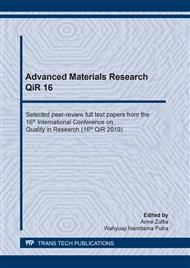p.210
p.220
p.227
p.233
p.238
p.248
p.257
p.265
p.272
Surface Mechanical Properties of Tool Steel on the Addition of Carbon Nanotubes with the Process of Flame Spray Tungsten Carbide Coatings
Abstract:
Tungsten Carbide (WC) hard coating is widely used to coat the surface of the steel tools which provide tribological properties. In this paper, 0.25 wt% & 0.35 wt% of Carbon Nanotubes (CNT) were mixed with tungsten carbide (WC) powders as the feedstock powders. Method of solution dispersion in ethanol media using an ultrasonic device was used for coating the surface of WC powders with CNT powder. The mixed powders were then used as the feedstock powder to coat onto the surface of tool steel using the flame spraying process. The coated surface microstructures were observed under a scanning electron microscope (SEM), x-ray diffraction (XRD), and the energy dispersive spectroscopy (EDS) was used for the phase characterization and identification. The wear rate of coated steels was determined using the Ogoshi machine, and the Vickers hardness method used to measure their microhardness. The effects of CNT on the microstructure of the coated material and the surface mechanical properties were investigated. The results showed that the mixture powder preparation using an ultrasonic method in SDS solution and the ball-milling process was suitable to disperse the CNT on the surface of WC feed powders due to produce an adequate relationship between CNT' and WC powders increasing the surface mechanical properties of coatings. The wear resistance of the coated material produce using the mixture of WC powder with 0.35 wt% CNT increased around 50% higher than the WC coated steel without CNT addition. Also, the hardness of coating reinforced CNT increased significantly compared with the hardness of WC coated and the steel substrates. Microhardness value from the base metal to the WC-CNT coated steel increased from 550 HV to 1717 HV and also the wear rate from the base metal to the WC-CNT coated steel decreased from 0.86 mm3/min to 0.017 mm3/min. These results indicate that CNT is an excellent alternative to improve the surface mechanical properties of WC coatings.
Info:
Periodical:
Pages:
238-247
Citation:
Online since:
July 2020
Authors:
Price:
Сopyright:
© 2020 Trans Tech Publications Ltd. All Rights Reserved
Share:
Citation:


